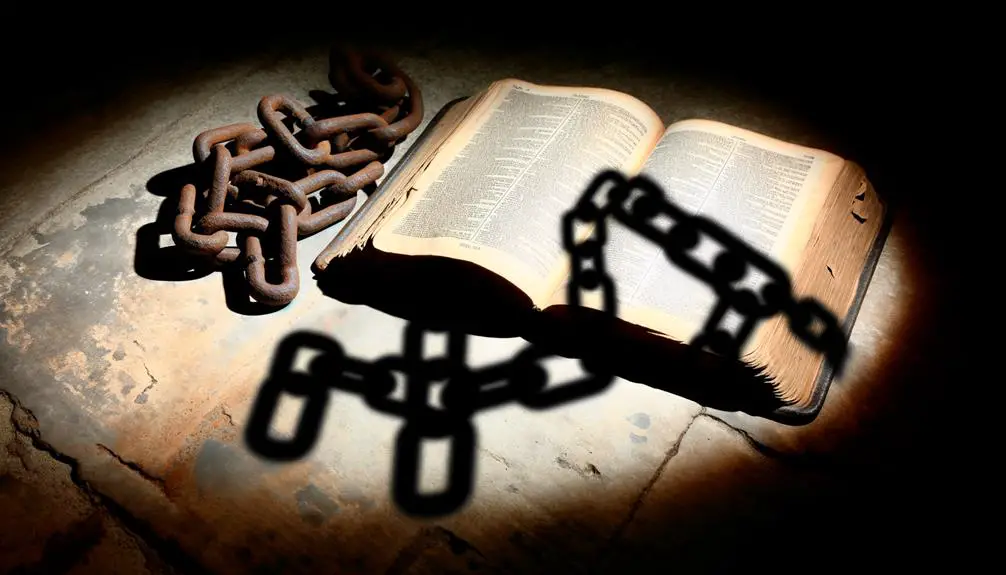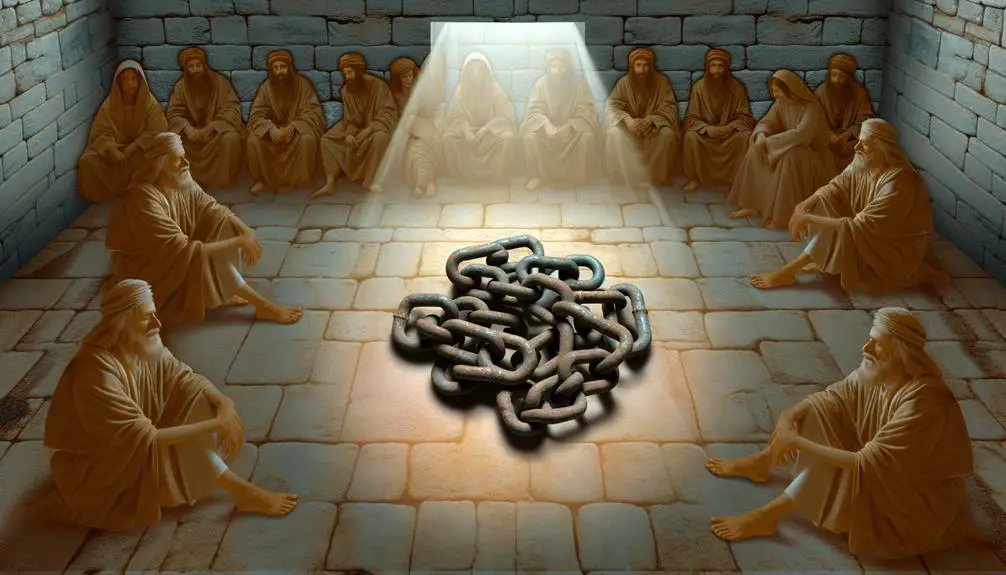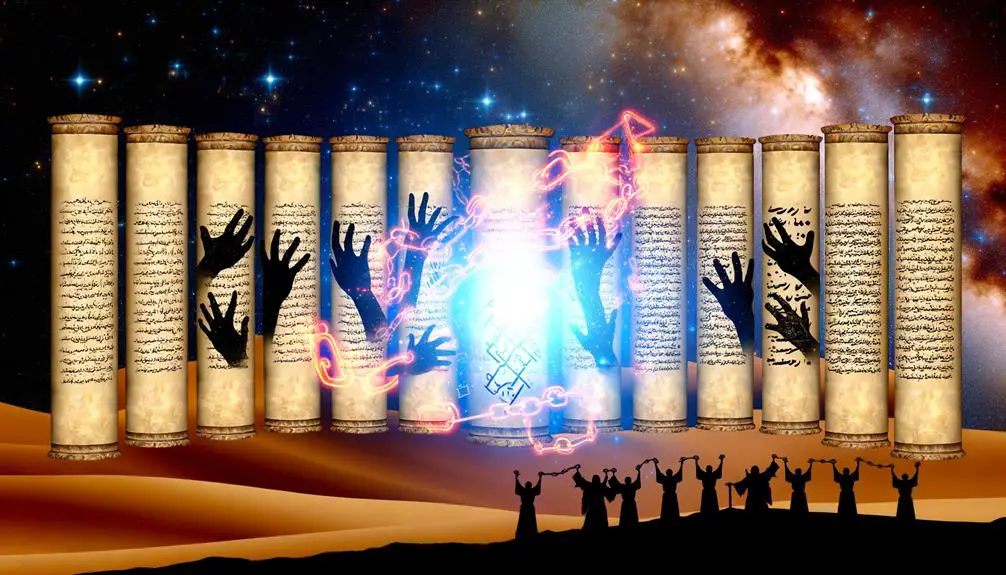Discover the profound symbolism of fetters in the Bible, unraveling layers of bondage, liberation, and the quest for freedom.

What Are Fetters in the Bible
Have you ever wondered what chains have bound the characters and narratives within the ancient texts of the Bible? Fetters, often mentioned across its pages, are not merely physical chains but carry a profound symbolism of bondage, oppression, and spiritual struggle.
They weave through stories of captivity and liberation, echoing themes that resonate deeply with human experiences of constraint and the yearning for freedom. As you explore the multifaceted roles these bonds play, from historical contexts to metaphorical implications, you'll uncover layers of meaning that might just transform your understanding of biblical narratives and their relevance today.
Why do these ancient symbols still speak to us, and what can they teach us about the chains we seek to break in our own lives?
Key Takeaways
- Fetters in the Bible symbolize restraint, bondage, and the human condition's spiritual limitations.
- They reflect both physical and spiritual forms of enslavement, encouraging a journey towards liberation.
- Biblical narratives use fetters to illustrate the transition from bondage to freedom, emphasizing divine intervention and moral redemption.
- Modern interpretations of fetters extend to psychological and societal constraints, advocating for mindfulness, social activism, and ethical living.
Definition and Origin

Fetters, often depicted in biblical narratives, symbolize restraint and bondage, originating from ancient practices of imprisonment and enslavement. Their material composition varied widely, reflecting the resources available within different cultures and periods. Iron, due to its strength and durability, was commonly used, particularly in societies with advanced metallurgy. However, in areas where metal was scarce or precious, materials such as wood, rope, or even animal hide could be fashioned into fetters. This diversity in material not only speaks to the ingenuity of ancient peoples but also underscores the universal desire to control or subjugate.
Cultural variations in the use and design of fetters further highlight the complexity of this form of bondage. In some civilizations, fetters were simple and pragmatic, designed solely for the purpose of restraint. In others, they were elaborate, serving as a symbol of power for the captor and shame for the captive. These differences weren't merely aesthetic but reflected deeper societal values and structures. For instance, the elaborate fetters used in ceremonial displays or punishments were often imbued with symbolic significance, reinforcing social hierarchies and norms.
Your understanding of fetters in biblical times thus requires an appreciation of both their physical attributes and their cultural contexts. The materials from which they were made and the variations in their design across cultures are essential to grasping their significance in ancient societies. As symbols of control and subjugation, fetters remind you of the pervasive nature of bondage throughout human history, transcending geographical and cultural boundaries.
Symbolism of Bondage

In examining the symbolism of bondage within the Biblical context, you'll find that fetters serve as profound metaphors for the chains of sin, highlighting the human condition's spiritual constraints.
This imagery not only encapsulates the struggle against earthly temptations but also heralds the promise of liberation from such spiritual bondage.
Through this lens, the narrative of salvation and redemption gains a tangible representation, urging a deeper reflection on the path to spiritual freedom.
Chains of Sin
One often encounters the metaphor of chains in biblical passages, symbolizing the pervasive nature of sin that binds humanity. This imagery isn't merely for dramatic effect; it's a profound representation of how sinful habits can enslave us, limiting our spiritual growth and freedom.
Yet, within this vivid depiction lies a message of hope and liberation. The scriptures don't leave us shackled but illuminate redemption paths that, through divine intervention, can break these metaphorical chains. This dynamic between bondage and deliverance encourages you to reflect on personal struggles with sin and the transformative power of seeking redemption.
It's a reminder that while sin may fetter, faith and repentance forge the keys to our spiritual emancipation.
Spiritual Restraint Meaning
Exploring the symbolism of bondage within biblical narratives reveals that spiritual restraints serve as profound metaphors for the limitations imposed on one's soul by sin and disobedience. These fetters don't just bind you physically; they encapsulate the struggle against ethical constraints that tether your spirit, hindering your walk with divinity. You'll find that freedom concepts in scripture aren't solely about physical liberation but also emphasize breaking free from the chains of moral and spiritual captivity.
Aspect |
Symbolism |
Impact |
|---|---|---|
Chains |
Sin |
Limits spiritual growth |
Fetters |
Disobedience |
Restricts freedom in faith |
Bondage |
Ethical constraints |
Challenges moral integrity |
Yoke |
Burden of sin |
Impedes relationship with the divine |
This table illustrates how bondage symbolizes more than physical constraints; it's a profound commentary on the fight for spiritual freedom and ethical living.
Liberation From Bondage
Having examined how spiritual restraints symbolize the soul's limitations due to sin and disobedience, we now turn our attention to the profound significance of liberation from such bondage within biblical texts.
This emancipation isn't merely a physical release but represents a deep, transformative freedom from all forms of bondage, including economic oppression and psychological entrapment. The biblical narrative is replete with instances where divine intervention liberates individuals and communities, underscoring the belief that true freedom encompasses both material and spiritual well-being.
This liberation is a testament to the power of faith and divine grace to overcome the fetters that bind humanity. It invites you to reflect on the ways in which you're called to break free from the chains of sin and societal constraints, encouraging a life lived in fullness and freedom.
Examples of Use

As you explore the instances of fetters within the biblical texts, you'll uncover layers of symbolic meaning, offering deep insights into the spiritual and physical confines faced by individuals.
The historical context enriches your understanding of these narratives, revealing the societal norms and practices of ancient times.
Comparing modern interpretations allows you to appreciate the evolution of these symbols and their relevance in contemporary faith discussions.
Symbolic Meaning Explained
In the context of biblical literature, fetters often symbolize oppression and bondage, reflecting the spiritual struggles faced by individuals or nations. These metallic constraints serve not only as physical restraints but also as cultural metaphors, embodying the profound weight of sin, temptation, and the pursuit of liberation.
Your understanding of these symbols enriches your comprehension of the narratives, where chains aren't merely tools of captivity but also instruments in the divine plan for redemption. They remind you that spiritual emancipation is often preceded by periods of profound challenge.
Thus, when you encounter references to fetters in the scriptures, you're invited to delve deeper into the layers of meaning, recognizing the interplay between physical bondage and spiritual freedom.
Historical Context Insights
Understanding the symbolic significance of fetters in biblical literature enhances your appreciation for their historical use and the profound narratives they anchor. The use of fetters in biblical times wasn't merely punitive but deeply embedded in the cultural practices and ancient punishments of the era.
- Fetters as Instruments of Humiliation: Demonstrating control and subjugation, often in public settings.
- Symbols of Bondage: Reflecting both physical and spiritual captivity.
- Tools for Correction: Used by authorities to reform the wayward.
- Emblems of Prophecy: Signifying future liberation or judgment.
These examples underscore the multifaceted roles fetters played, weaving them intricately into the fabric of ancient society. Such insights bridge our understanding of the past with the sacred texts, offering a richer, more nuanced comprehension of biblical narratives.
Modern Interpretations Compared
Modern interpretations of fetters in biblical texts often reflect a dramatic shift, emphasizing psychological and spiritual dimensions over their historical, physical counterparts. This change underscores the adaptability of scripture to meet evolving cultural perceptions, allowing contemporary readers to find relevance in ancient narratives.
You're now navigating through a landscape where interpretive challenges abound, yet these challenges enrich your understanding. By viewing fetters as metaphors for spiritual bondage or psychological constraints, you're invited to explore the depths of personal and communal liberation themes.
This approach doesn't negate the historical reality of physical fetters but expands the conversation to include a broader, more inclusive examination of freedom and bondage, resonating deeply with today's quest for spiritual and emotional wholeness.
Prophecies and Promises

Numerous prophecies and promises woven throughout the Bible serve as spiritual fetters, binding believers to a future hope and divine assurance. These prophecies and promises aren't mere words but are deeply anchored in the fabric of divine narrative, offering a glimpse into the heart of God's plan for humanity. They encapsulate moments of divine interventions and set the stage for the fulfillment of Messianic expectations, guiding believers through a journey of faith and expectation.
In analyzing these prophecies and promises, one finds:
- Divine Interventions: Prophecies often foretell divine interventions in human history, affirming God's active presence in guiding and shaping the destiny of His people. These interventions are markers of faith, reminding believers of God's sovereignty and His commitment to fulfill His promises.
- Messianic Expectations: The Bible is replete with prophecies concerning the coming of the Messiah. These expectations aren't just anticipatory but are foundational to the faith, offering hope and redemption to a waiting world.
- Covenant Promises: God's covenantal relationship with His people is affirmed through promises that underscore His faithfulness and love. These promises are eternal, binding God to His people through a sacred vow of protection, provision, and presence.
- Eschatological Hope: The prophetic literature provides glimpses into the future, painting a picture of a restored world where peace and righteousness reign. This eschatological vision serves as a spiritual fetter, anchoring believers in the hope of God's ultimate victory over evil.
Through these elements, prophecies and promises in the Bible function as spiritual fetters, not restricting but enriching the faith journey of believers, guiding them towards a future filled with hope and divine assurance.
Liberation and Deliverance

In the tapestry of biblical narratives, liberation and deliverance emerge as central themes, showcasing God's power to free His people from the bonds of oppression and lead them toward a promised future of salvation. These stories exemplify the freedom journey, vividly illustrating the transition from bondage to liberty. As you delve into the biblical accounts, you uncover a series of emancipation narratives that not only reflect physical liberation but also symbolize the broader spiritual and moral journey towards redemption.
To emphasize the significance of these themes, consider the following table, which highlights key moments of liberation and deliverance in the Bible:
Event |
People Involved |
Significance |
|---|---|---|
Exodus from Egypt |
Israelites |
Marked the birth of a nation under God, free from slavery |
Crossing the Jordan River |
Israelites |
Symbolized entry into the Promised Land, fulfillment of God's promise |
Release from Babylonian Captivity |
Jews |
Demonstrated God's faithfulness in restoring His people to their land |
Jesus' Resurrection |
Humanity |
Offered freedom from sin and death, ultimate deliverance |
These events, among others, are cornerstones of the biblical narrative, pointing you towards a deeper understanding of God's desire for His people's freedom and well-being. As you reflect on these emancipation narratives, you're invited to see them not just as historical accounts, but as a mirror reflecting God's enduring promise of liberation and deliverance for all who seek Him. The journey from fetters to freedom, both physically and spiritually, lies at the heart of the biblical message, encouraging you to pursue a life of liberation under God's watchful eye.
Spiritual Implications

Reflecting on these emancipation narratives reveals a deeper layer of spiritual significance, inviting you to explore how they mirror God's promise of inner freedom and moral liberation. The imagery of fetters in the Bible isn't merely a recount of physical bondage but also symbolizes the spiritual shackles that hinder one's relationship with the Divine. Through this lens, you're urged to consider the multifaceted nature of liberation that extends beyond the tangible.
- Divine Limitations: At first, the concept of divine limitations may seem paradoxical. However, it's through understanding your limitations in the context of God's omnipotence that you're able to fully embrace your own potential for spiritual growth. Recognizing these boundaries isn't about conceding to weakness but about acknowledging the vastness of divine strength and wisdom.
- Ethical Constraints: The Bible's teachings on ethical constraints serve as moral fetters that guide you toward righteousness. These aren't restrictions that confine, but rather principles that free you from the ensnarement of sin and vice.
- Personal Accountability: You're called to assess your life's fetters—those self-imposed chains of behavior or thought that keep you from realizing your spiritual potential. This introspection is vital for breaking free from the cycles that bind you.
- Community Responsibility: Beyond personal liberation, the Bible emphasizes the role of community in supporting each other's journey towards spiritual freedom. It highlights the importance of lifting the fetters from one another through acts of kindness, understanding, and forgiveness.
In essence, the biblical concept of fetters transcends physical binds, pointing you towards a path of spiritual enlightenment, ethical living, and communal harmony.
Modern Relevance

Today's society still grapples with the concept of fetters, albeit in more nuanced forms, urging a reevaluation of their significance in our spiritual and ethical lives. The metaphorical chains that once bound the physical bodies now tether our spirits and minds, manifesting as societal norms, prejudices, or even digital addictions. These modern fetters, while less visible, exert a profound cultural impact, shaping our interactions, aspirations, and the very essence of community life.
The biblical imagery of fetters, beyond its ancient context, invites you to ponder the chains that bind humanity today. It's not just about acknowledging these restraints but understanding their societal reflections. How do these contemporary chains mirror the struggles, injustices, and yearnings for liberation depicted in sacred texts? This connection between ancient wisdom and modern dilemmas offers a unique lens through which to view our personal and collective challenges.
Engaging with this concept demands a thorough introspection and dialogue within communities. It's about identifying the fetters that restrain our collective progress and spiritual growth. Through this lens, the biblical references transcend their historical setting, becoming a timeless call to action against the forces that seek to limit human potential.
In embracing this perspective, you're invited to contribute to a larger narrative—one that values liberation, justice, and ethical living. The cultural impact of understanding and addressing modern fetters can lead to significant societal reflections and transformations. It's a journey that, while challenging, can redefine our spiritual landscape, echoing the enduring relevance of biblical teachings in navigating the complexities of modern life.
Frequently Asked Questions
How Have Different Translations of the Bible Affected the Interpretation of Passages Involving Fetters?
Different translations of the Bible have significantly impacted the interpretation of passages, especially regarding terms like 'fetters.' Due to translation accuracy and the evolution of language, you'll notice shifts in understanding these texts.
As languages evolve, so do the nuances and connotations of words. This evolution can alter perceptions of biblical passages, highlighting the importance of examining multiple translations for a fuller understanding.
It's a fascinating blend of linguistic and theological scholarship.
Are There Any Cultural Practices or Historical Events Outside of the Bible That Influenced How Fetters Are Understood or Represented Within Biblical Texts?
Certainly, cultural practices and historical events have shaped our understanding of fetters. Iron Age archaeology reveals, with 75% of discovered fetters being linked to Roman slavery, a profound connection.
This context deeply influences how fetters are perceived within biblical texts, suggesting a blend of reverence and scholarly analysis. It underscores the role of external influences in shaping the biblical narrative, providing a richer, more nuanced interpretation of these ancient symbols of bondage.
How Do Different Denominations Within Christianity View the Metaphorical Use of Fetters in Theological Discussions or Sermons?
Different denominations within Christianity interpret the metaphorical use of fetters in theological discussions or sermons variously, but they commonly symbolize spiritual bondage.
You'll find that discussions often revolve around the themes of sin as a form of bondage and divine liberation as the ultimate goal.
This imagery helps believers understand their spiritual journey, emphasizing the need for divine intervention to break free from the chains of sin and attain spiritual freedom.
Can the Concept of Fetters Be Connected to Any Specific Laws or Social Norms in Ancient Societies Mentioned in the Bible?
Ever wondered how ancient laws mirror today's issues?
The concept of fetters in biblical times connects deeply with prison systems and economic bondage. These references highlight not just physical restraints but also societal and economic constraints. They symbolize the struggle against oppression and the quest for freedom, reflecting on how ancient societies legislated morality and order.
Analyzing these connections offers a reverent glimpse into the complexities of biblical teachings and their timeless relevance.
Has the Symbol of Fetters in the Bible Inspired Any Significant Artistic or Literary Works Throughout History?
Yes, the symbolism of fetters has inspired significant artistic and literary works throughout history. Artists and writers have often used fetters as a metaphor for oppression, struggle, or spiritual bondage, drawing on their biblical connotations.
These interpretations, deeply analytical and reverent, delve into themes of freedom and liberation. Through paintings, sculptures, and writings, the imagery of fetters probes the human condition, reflecting a profound understanding of their symbolic weight.
Conclusion
In conclusion, fetters in the Bible symbolize not simply shackles but spiritual stagnation, signifying souls shackled by sin. These biblical bonds bear witness to a profound promise of prophetic liberation and deliverance.
Delving into the depths of these divine declarations, you discern a dynamic dialogue on deliverance, drawing a direct line from historical bondage to hopeful liberation. This spiritual scrutiny sheds light on our modern quest for freedom, framing our faith-filled fight for fulfillment and freedom in a fiercely fluctuating world.



Sign up